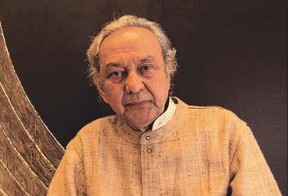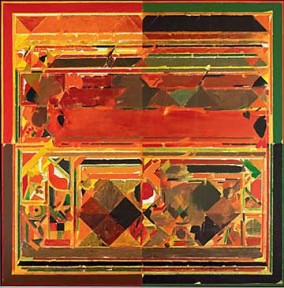 When you are given a ‘post-lunch’ appointment with the grand old man of Indian art, Syed Haider Raza – whose homecoming this January after having lived and worked in Paris for over six decades as been as much in news as the record breaking acrylic on canvas Saurashtra that went for a whopping Rs 16.4 crore at a Christie’s auction last year – you want to be punctual. And prepared. I have mugged up all the facts on the artist who, at 89, is recovering from a hip surgery and, as I have been cautioned, will be able to “spare only a few minutes”. But nothing has prepared me for the alertness with which Raza Saheb, as he is affectionately called, greets me at the door of his first floor flat in South Delhi. His warm smile says what he doesn’t announce in words.
When you are given a ‘post-lunch’ appointment with the grand old man of Indian art, Syed Haider Raza – whose homecoming this January after having lived and worked in Paris for over six decades as been as much in news as the record breaking acrylic on canvas Saurashtra that went for a whopping Rs 16.4 crore at a Christie’s auction last year – you want to be punctual. And prepared. I have mugged up all the facts on the artist who, at 89, is recovering from a hip surgery and, as I have been cautioned, will be able to “spare only a few minutes”. But nothing has prepared me for the alertness with which Raza Saheb, as he is affectionately called, greets me at the door of his first floor flat in South Delhi. His warm smile says what he doesn’t announce in words.
Insight 1: Punctuality pays. The interview stretches over two hours, Mr Man Friday has been banished to an adjoining office cum drawing room.
The only visible change is the wheelchair in which he is seated, making him look frighteningly frail as he is manoeuvred into the living room by a day help, and the barely audible whisper that was once a deep baritone voice. What has remained intact is the passion with which Raza talks about his rustic upbringing in the village of Babaria in Madhya Pradesh and the journey from being the co-founder of the revolutionary Progressive Artists Group to his Parisian experiences till he came back to India to become “a tax paying citizen of my own country”.
 In his living room, some completed and one incomplete canvas stand tall on an easel. A rough sketch of the Cross lies on the side along with a freshly opened box of colours. “I try to paint two hours in the morning and for some time in the afternoon. I want to do a show of my recent works which is about God. The horizontal and vertical lines of the cross on which Christ was crucified attracts me for its geometrical symbolism,” says the artist who has made the Indian mystical form of bindus and mandalas his signature metaphor since the eighties.
In his living room, some completed and one incomplete canvas stand tall on an easel. A rough sketch of the Cross lies on the side along with a freshly opened box of colours. “I try to paint two hours in the morning and for some time in the afternoon. I want to do a show of my recent works which is about God. The horizontal and vertical lines of the cross on which Christ was crucified attracts me for its geometrical symbolism,” says the artist who has made the Indian mystical form of bindus and mandalas his signature metaphor since the eighties.
Insight 2: Never ask an artist, however old he is, if he is considering voluntary retirement. This is one job that pays best when you work less. Art market calls it “rare masterpieces”.
It was a childhood incident, that Raza still remembers vividly, which introduced the “recalcitrant” student to the bindu. “I was not good at studies at all and had great difficulty in focusing in class. My teacher once drew a bindu on the blackboard and asked me to concentrate on it for hours without thinking anything else. Later, in art colleges, like other artists of my time, I too was trained in European realism but when I began to ask myself in the eighties where India was in my work, it was this bindu that resurfaced in my consciousness, along with the pancha tattwa – the five basic colours of red, yellow, black, blue and white.”
Talking of his early childhood as the son of a forest officer, Raza recalls his proximity to river Narmada surrounded by the Satpura and Vindhyachal mountain ranges, dense forests, birds, animals, tribal life, symbols and mythology – all that influenced his early expressionistic landscapes. It was the same time, in 1947, that Raza co-founded the Bombay Progressive Artists’ Group with the likes of KH Ara and FN Souza, but then moved to France in 1950, first to study at Ecole Des Beuax Arts in Paris and then to “settle down” as a married man “for the sake of my French wife whose mother would be heartbroken if she had relocated to India instead.”
“I loved the French culture and French girls are so pretty. Kaajal ki kothri mein kaiso hi suhaano jaaye, ek lakeer kaajal ki laage hai so laage hai (however clean you may be when you enter a room full of black colour, you are bound to get some on yourself),” he winks, remembering how he was attracted to and resolutely avoided fellow art student Janine for several years before succumbing into marrying her.
Insight 3: Men can turn naughty even at 90. And if it is Raza, who can recite love couplets in flawless Urdu and Hindi while breaking into French every now and then, you have no choice but to blush.
It was in France that Raza began to slowly move away from an expressionistic mode towards greater abstraction and began to explore elements of tantric symbolism from Indian scriptures. By the late 70’s, Raza had begun making frequent trips to India in order to find a “new direction” and move away from what he calls “plastic art”. “I visited caves of Ajanta-Ellora, Benaras, Gujarat and Rajasthan, spent years researching my Indian roots and culture. The Hindu language, dharma, philosophy and sanskriti moved me deeply.”
The result was bindu, which signified his rebirth as a painter and which Raza perceives as the centre of creation as well as energy, sound, space and time. Over time, Raza had added newer dimensions to his work – the Tribhuj (Triangle), Prakriti-Purusha (male-female energy) and more recently since 2000, Kundalini, Nagas and the Mahabharata. What also set his canvases ablaze were the choice of colours – dark reds, greens, maroons and yellows.
In the recent series of work, which Raza has been working on since his return to India, he has chosen to go subtle. The colours are far more muted and the strokes gentler. In an all white canvas with a central bindu form titled Shwetabh (Glow of White), his focus is on harmony – religious in this case. “I visit all religious places of worship – whether it is a temple, church or a mosque. The essence of all religions is one and that is compassion. As an artist, it’s my dharma to see this message reaches out to more and more people.”
Insight 4: The power of art lies in its ability to portray that mainstream Hindu ideas and Muslim beliefs are everyday aspects of faith and reality in the Indian way of life. One is not alien to the other. There are no strangers here or foreign issues, simply shared knowledge.
While Raza is steadfast in his yearning to spend the rest of his life “living and working in the land of Mahatma Gandhi”, he does not hesitate in sharing his angst about two most important issues that currently trouble him – the hype over art prices and the lack of a proper art infrastructure in the country. “No one talks or writes about how an artist’s oeuvre has evolved. There is no academic interest in art even within the media. Everyone is interested in just talking about what price a painting sold at an auction. I worked hard for 60 years before my work got any attention. The focus on prices is making the younger generation consider art as a moneymaking exercise. Sadly, there are no short cuts to long term success in this journey.”
To do his own bit, however, the artist has set up the Raza Foundation in India which promotes art among Indian youth and also gives away the Annual Raza Foundation Award to young artists. The next stop is the Raza Museum, which he is planning if “we get the appropriate land in Delhi” from the government. “I have another eight to 10 years to live, hopefully,” he smiles, “I hope the government listens to us and does the needful. Unfortunately, in India, museums are few, books on contemporary art hardly exist and the officials at our embassies don’t promote art the way the Chinese do. I know there are many hurdles to be crossed before we have the museum.”
Insight 5: No advice can be enough for a culture-ignorant state, even if it comes from SH Raza.
Poonam Goel is a freelance journalist and has covered the arts for over 15 years. She contributes on visual arts for various newspapers, magazines and online media. More about her on Story Wallahs. Write to her @poonamgoel2410@gmail.com






Loved the way you have portrayed Raza…an old story with a new flavour :):):)
Amazing piece, Poonam … thoroughly enjoyed it!
very differently written……